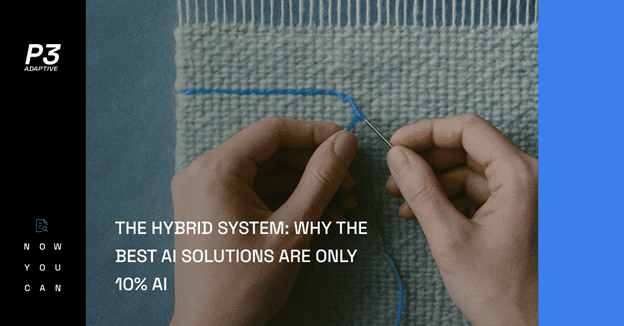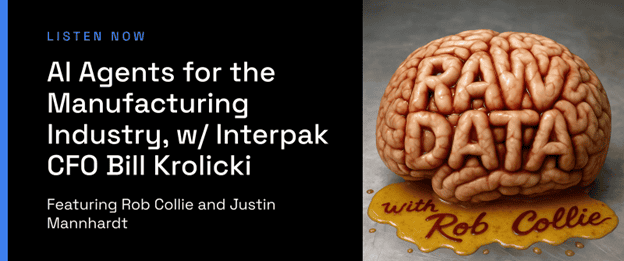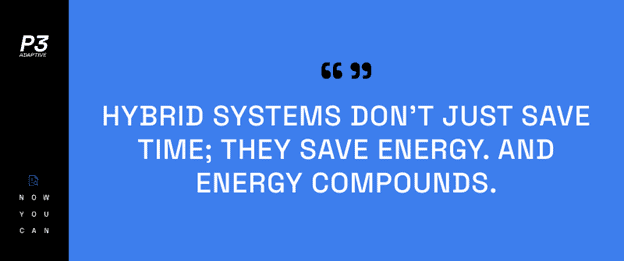
The Hybrid System
People expect AI to do everything.
That’s the problem.
The best results come when AI does almost nothing.
On a recent episode of Raw Data with Rob Collie, Rob talked with Bill Krolicki, CFO at International Packaging — a guy who’s actually built AI that works in production. Not a pilot. Not a demo. Real systems that make the business run smoother every day.
And here’s the twist: the magic doesn’t come from piling on more AI.
It comes from using less — and being deliberate about where that AI belongs.
The Train Wreck Phase
Bill’s first AI project looked a lot like everyone else’s: ambitious, hopeful, and doomed.
The problem was simple. Suppliers were supposed to deliver materials on time. Sometimes they didn’t. Usually, they didn’t mention it until delivery day, and suddenly the whole production schedule was toast.
So Bill thought, “Let’s use AI to fix this.”
He gave the AI access to the open purchase-order table and asked it to manage delays — a move he later called “a train wreck.”
That moment, the train-wreck phase, is where most organizations are stuck right now. They drown the model in too much context, too many decisions, too much responsibility. Then they’re shocked when it stumbles.
You can almost hear the system sigh. “You want me to do what now?”
The Breakthrough: Radical Simplicity
Here’s where it clicked. Bill stopped trying to make AI the hero and built a hybrid system where each piece did exactly what it’s best at.
Power Automate pulls the purchase orders due next week from the Power BI data model, formats them into a clean table, and sends automated emails to vendors:
“Here’s what we’re expecting. If it’s going to be late, let us know.”
That’s just automation — reliable, predictable, no AI needed.
The AI’s actual job? Read the replies.
That’s it.
When a vendor says, “looking more like the 18th,” the AI answers one question: Is this going to be late?
If yes, it calculates the new date and triggers the next step.
Small job. Big payoff.
And the best part? No drama. No hallucinations. Just a clean little system doing exactly what it’s supposed to.
Why This Works
Bill said it best:
“If I want deterministic — the right answer — I use code. That’s where Power BI shines. I can write the query, get the truth, and the AI can go from there.”

Let’s translate that.
- Deterministic work — numbers, formulas, queries — belongs to code.
- Probabilistic work — language, intent, context — belongs to AI.
The trouble starts when you ask AI to do both. LLMs aren’t great at math. They’re great at meaning.
Ask them to understand that “looking more like the 18th” means “three days late”? Perfect.
Ask them to write the same query twice? You’re gambling.
The “Intern” Model
Bill’s analogy nails it: AI is like an intern.
You don’t hand an intern your entire ERP system and say, “Figure out what’s late and fix it.” They’ll panic.
You give them something specific.
“Here’s what’s due. Read these emails. Tell me if anything’s late.”
That’s manageable. That’s useful.
And — just like a good intern — you keep them looped in but not in charge.
When the AI flags a late shipment, it doesn’t go rogue updating systems. It sends the purchasing manager a summary with buttons: Update PO? Notify sales?
AI does the grunt work.
Humans make the call.
It’s boringly effective — which, honestly, is what good systems should be.
The Architecture That Actually Works
Power BI handles the math. Provides trusted, structured data.
Power Automate orchestrates the workflow, sends the emails, moves the parts.
AI reads human language and fills in the fuzzy gaps.
Each layer does its job — and that’s the point. None of them’s trying to be a superhero.
The AI is maybe 10 percent of the system, but it’s the 10 percent that makes the other 90 percent usable by humans.
If you’re building on Microsoft Fabric, this architecture scales beautifully. Fabric handles the semantic model and unified data layer while Power BI and AI agents handle execution.

When AI Gets in Its Own Way
Justin spotted it during the conversation:
“People watch AI write a query once and think, oh, it can do that every time.”
It can’t. Not reliably.
Ask it the same question twice, and you’ll get different code both times. That’s fine for exploration. Not for production.
The fix? Let AI help you discover the right queries. Then lock them in.
Hard-code what works. Give the AI a toolbox, not a blank sheet.
That’s how you get reliability without losing intelligence.
The Accounts Receivable Bot
Every week, Bill’s AR bot finds customers 45+ days past due.
It sends the list to sales:
“Anyone here you don’t want to remind?”
The sales lead marks the exceptions — then the bot emails everyone else automatically.
Result? On-time vendor deliveries jumped from about 60 percent to over 80 percent, and it takes him maybe 30 seconds a week to stay on top of it.
He tells the story himself on Raw Data with Rob Collie — and yeah, it’s as good as it sounds.
Same pattern. Same principle.
AI handles the fuzzy bits (interpreting human input).
Power BI and Power Automate handle the workflow.
No magic. Just execution.
The Hidden ROI: Energy Cost
Bill said something that stuck with Rob:
“Even when it takes the same time with AI, I still feel better at the end.”
He’s talking about energy cost.
Without AI, you wrestle syntax, debug errors, curse the compiler. You finish drained.
With AI handling the mind-numbing parts, you finish with gas left in the tank.
Rob’s joked for years that “suffering” should show up on project budgets. The psychic injury is real.
Hybrid systems lower that cost. They don’t just save time; they save energy. And energy compounds.
What This Means for Your AI Strategy
Start with the workflow, not the AI.
Map the pain first. Figure out what happens, in what order, with what info.
Then find the fuzzy parts — the places where someone has to interpret language or context.
That’s where AI fits.
Everything else? Keep it deterministic.
Let Power BI handle the math. Let Power Automate run the motion.
And always, always keep humans in the loop.
AI gathers. Humans decide. That’s how you build trust.
Smaller jobs mean fewer surprises — and more wins.
The Budget Bot Vision
Bill’s next project? A Budget Bot that interviews department heads.
It shows historical spending (via Power BI), asks questions (“Percent or flat increase?”), and captures reasoning.
Next year, when reality doesn’t match the budget, it remembers:
“You said March would spike because you were hiring. Did that happen?”
It’s the same 90/10 principle.
Automation. AI. Human judgment.
This time, applied to budgeting.
The Counterintuitive Truth
The best AI systems are the ones where AI does the least.
Not because AI is weak — but because it’s strongest when it does exactly what it’s uniquely good at.
Bill’s vendor bot isn’t impressive because it’s cutting-edge. It’s impressive because it’s practical. Just enough AI, in just the right place, to solve a real problem.
That’s the formula:
90 % workflow. 10 % AI. 100 % effective.
It’s not flashy. It just works. Which, honestly, is the dream.
When You’re Ready
If you’re tired of six-figure demos that go nowhere, start smaller.
We’ll help you build your own AR Bot or Budget Bot — the kind of 90/10 system that actually ships value. And with our Two-Week Happiness Guarantee, you’ll see real results before you ever commit.
Let’s build something that works.
Get in touch with a P3 team member